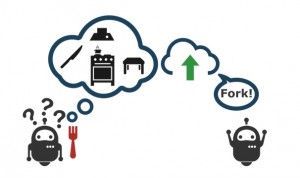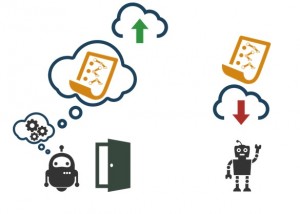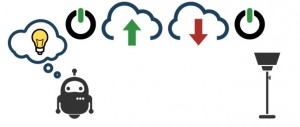The last 200 years have been crucial in terms of technological evolution, but the human brain has not changed much for the last 500.000 years. If we have about the same “computing power” as our ancestors, there must be some other reason for this huge boost.
We are not smarter than the first homo sapiens, we just have better ways to share information.
On the early 2000’s we had great expectations from robotics. We thought we would have robots all over the place improving our quality of life by now, but technology has failed our expectations and we’ve lost interest in this amazing field for the past 10 years. People are starting to be tired of expecting a revolutionary breakthrough that never comes.
https://www.google.com/trends/explore#q=robotics%2C%20%2Fm%2F02y_9m3&cmpt=q&tz=Etc%2FGMT-2
Clearly, other technologies such as cloud computing are evolving much faster and getting naturally adopted by users of all kinds. Think for example, about the amount of information we all share on the “cloud”.
Robots don’t need faster computer brains, they just need better ways to share information.
Cloud Robotics is the robot equivalent to our human learning and language skills. It is their way to share knowledge, information and process amounts of data that go far beyond from our current capabilities. Humans are not born knowing everything, we simply learn from each other and ask what we don’t know about.
Just imagine robots that could identify any object by simply asking about it in the cloud. What if your robot could access a database with recipes in order to cook your favorite meal? Think even bigger; robots could access any IoT sensor located anywhere because they use, as you do, its contextualized information.
There is no need to wait for another 50 years in order to get smarter robots able to share their knowledge. Nowadays, thanks to the increasing interest of Telecommunications companies in Cloud Computing and IT technologies, standard cloud platforms are starting to grow quickly, and we, at Ikergune are working towards an integration that will help making the most of these two worlds, Robotics and Cloud platforms.
The key to this breakthrough is working with standard and open source platforms, that’s why we chose ROS and FIWARE. ROS is the most active and standardized robotics software with a very active community of developers and FIWARE, thanks to the support of big telecom companies and the European Commission, is an open cloud platform growing very rapidly; exactly what the robotics community has been missing.
FIROS is an Opensource software that helps ROS connecting to the FIWARE Cloud. This connectivity lets robots making the most out of all the cloud services and allows all developers to manage and control connected robots even without being experienced roboticists.
Here is how FIROS will help robots being smarter:
Identifying unknown objects is easier and faster with FIROS. Robots are now capable of uploading a picture to the FIWARE cloud and get information, descriptions and instructions of use based on its 3D shape and contextual information such as the room where ti is placed. All this object information is located at your private server, a public object repository or requested to other connected robots.
Knowledge downloading is still science fiction for humans, but FIROS makes it a reality for robots. It is currently possible to teach robots through imitation so they learn how to open a door, what simply creates the required trajectories for its arms to operate the handle. Once this knowledge has been acquired, FIROS translates the new experience model to the FIWARE cloud so any other robot can download it and open that door. This is a powerful tool; one robot learns, they all benefit from its experience.
Using connected things is something we are starting to hear a lot about. We, humans, are getting used to the Internet of Things, but robots can now take it for granted! FIWARE is already compatible with many IoT sensors and actuators, what means that thanks to the intelligent integration provided by FIROS, any robot, is able to use any device… anywhere. There is no need for actual physical interaction with the light switch, robots will simply tell the lights to turn on.
By 2023, a computer will be equivalent to a single human brain in terms of computational power; by 2045 it will even surpass the computational power of all human brains combined together, but remember, it is not our computational power what makes us smarter, it is our ability to share knowledge, experiences and information. Robots are just at the edge of a new revolution, FIROS is the tool to make them smarter.
Let’s start sharing our experiences on the cloud, check out the FIROS repository in GitHub







